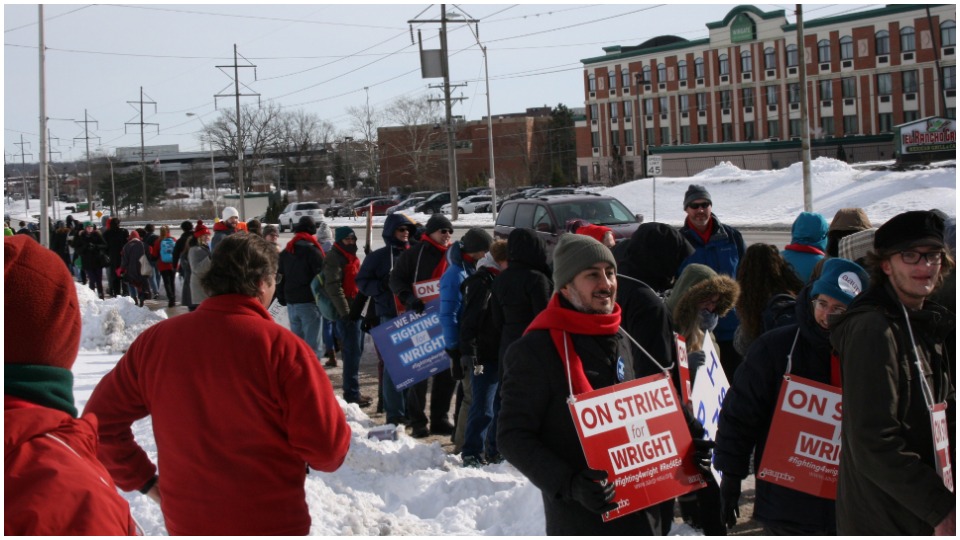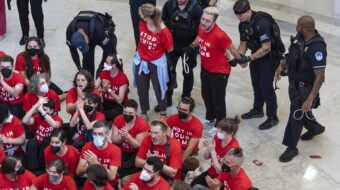
“Power, greed, and manipulation created this situation. We are seeking justice, out on the picket line.” — Skapones, “Out on the Picket Line”
DAYTON, Ohio—On a frigid day in January 2019, Wright State University (WSU) faculty walked out of their classrooms and laboratories, showing an arrogant and manipulative administration that it could not continue to ignore the power of the union. After a tumultuous three-week strike, one of the longest college strikes in U.S. history, WSU administrators finally agreed to a fair contract with faculty.
The lessons of the WSU Strike of 2019 were the subject of a presentation last weekend by two Wright State faculty members, Gretchen McNamara from the College of Liberal Arts, and John Martin, from the College of Business, to the 69th Annual Meeting of the American Association of University Professors—Ohio Conference. Wright State faculty are organized by the AAUP-OC.

McNamara and Martin began with the context of the strike. At the beginning of 2017, WSU was suffering the effects of extreme mismanagement. The administration was under multiple state and federal investigations, including a scandal over mishandling H-1B visas. Overspending of approximately $130 million for consultants and revenue-seeking schemes put the university at risk of being put under state fiscal watch.
When contract negotiations began, faculty knew they would “take a financial hit to help correct the administration’s mistakes,” according to AAUP-OC president John McNay. “But as negotiations unfolded, it became clear that the administration was not intending to let the budget crisis go to waste. Instead, they aimed to gut the faculty’s contract in what now seems a determined attempt to break the union.”
In 2018, the university proposed a contract with increases in workload, reductions in tenured staff, no raises, no job security for the non-tenure track eligible faculty, and removal of tenure track faculty’s chance to teach summer classes. Adding wage theft into the bargain, WSU administration proposed unlimited furlough days, when faculty would have to work but not get paid. From the time that she was hired in 2017, WSU’s president, Cheryl Schrader, simply refused to meet with union representatives.

In October 2018, the fact-finders’ report came out, and the AAUP-WSU rejected it 97 to 3. The union warned the administration that it was prepared to strike if the university imposed a contract. Sure enough, at the beginning of January 2019, the university imposed an even worse contract than the fact-finders’ report recommended. Workloads would increase dramatically, health care would be off the bargaining table altogether, raises were on hold, and “merit pay” would be tied to subjective criteria.
The AAUP-WSU called for a reauthorization of the strike vote. Gretchen McNamara spoke about the intense faculty discussions that preceded each decisive vote. She mentioned one fraught moment in particular, when the then-president of the faculty senate, who was not expected to disclose whether he was going to vote to support the strike or not, stood up and said, “I can tell you one thing, if this body authorizes the strike, then I will be on strike.” “As a leader,” Gretchen said, “he stepped into that moment.” Ninety-four percent of faculty voted, and of those, 85% voted to strike. The union filed the 10-day notice and strike preparations went into high gear. The walkout began Jan. 11, 2019.
The foundations of the strike’s successes were laid that fall, when the union launched a broad contract campaign. McNamara and Martin called those efforts extremely labor-intensive but crucial. Throughout the fall of 2018, hundreds of AAUP-WSU members attended Board of Trustees’ meetings, arguing their case in person. Four subcommittees were formed and began their work. One subcommittee researched health care options for the striking faculty members. Another coordinated the strike mobilization itself, renting a hall in a hotel near campus to serve as strike headquarters.
The third subcommittee worked on student and community outreach and was very successful. Students rallied and marched for their teachers both before and during the strike and popularized the hashtag #students4faculty. One afternoon during the strike, students staged a sit-in outside the university president’s office with tape over their mouths. Their message for the president, taped to their backs, was: “You silenced us, which is something our faculty don’t do.”
Prof. Martin remarked that the sit-in was completely organized by students alone. “It was their energy, their ideas, their ingenuity; it was phenomenal.” Ironically, WSU features glossy photos of 1960s-era protests in its official magazines, but in this case, the university president completely ignored the students in the hallway outside her office.
In another outreach effort, the union became an affiliate of the AFL-CIO, and other union members, including ironworkers, communication workers, carpenters, and teamsters, showed their solidarity by joining faculty on the picket line. Members of AAUP chapters from Cincinnati, Bowling Green, Kent State, Akron, Columbus, and Oberlin sent members to join the picket lines.
Media outreach was the focus of the fourth subcommittee. Reporters from the Dayton Daily News were said to be on the speed-dials of union organizers, who made themselves readily available to the press. The media showed some videos that proved embarrassing to administrators, including WSU Trustees expressing scorn for the humanities and disrespect for professors. A ska band with some personal connections to Wright State composed and recorded a song in honor of the AAUP-WSU strikers, “On the Picket Line” (available on YouTube). Twitter hashtags like #whywestrike, #faculty4students, and #fighting4Wright kept the latest strike news in people’s social media feeds, with very wide reach. McNamara and Martin showed that some of the union’s posts about the strike reached more than 62,000 social media users.
Communication with union members was sometimes challenging. Prof. Martin remarked on the high degree of stress and uncertainty among the faculty, especially about health care and the unknowable length of the strike. He told the audience here that union organizers focused first on integrity and truthfulness and never gave sugar-coated answers. As a result, he said, faculty had a high degree of confidence in AAUP leadership.
The most important message of the union was that state universities must be recognized and respected as a public good. That argument, said Prof. Noeleen McIlvenna, the AAUP-WSU Contract Administrator, in a “Working People” podcast recorded on the eleventh day of the strike, is the only way to unite engineering and business faculty with arts faculty and scientists, who all have very different points of view and often very different salaries. The “unifying factor” is the attack on public education in general. Dr. McIlvenna, who teaches early American history at Wright State, sees public education as a core American value from the earliest days of the republic. What motivates all kinds of faculty to stay on the picket line is that “professors here see that bigger picture—that we’re fighting for education.”
According to AAUP National President Rudy Fichtenbaum, who also served as chief negotiator for the AAUP-WSU, the university’s fiscal woes and the attempt to undermine the union are linked, both part of a neoliberal agenda which “seeks to destroy public services and public goods.” In higher education in particular, he said, “it’s leading to a privatization of public universities and colleges… These institutions more and more are being starved from public resources and have to rely more on tuition. Then when there’s no more tuition, they’re forced to go out and look for a variety of other schemes at raising money. This is something that is really undermining public higher education.”
Coordinating the picket lines was a huge effort, especially through Ohio’s polar vortex. Picket-line sign-up forms were kept as Google files, where faculty signed up for shifts. The set-up of picket line locations often involved shoveling snow to make room for tents and tables. The union got permission from a local market to use its parking lot as a staging ground for moving people to picket lines where there was no parking available.
McNamara and Martin reported that one of the most effective events occurred in week three of the strike, when a “Take Back Wright State March” brought students, faculty, and community members together for one event. About 350 people surrounded the university’s administrative building, encircling it with both clockwise and counter-clockwise marchers. Everyone got to see others’ faces, they said, boosting everyone’s morale. Plus, the university’s president looked out her office window and met the eyes of the defiant marchers. In another event, a busload of faculty went to Columbus to demonstrate at the Ohio State House, where they were joined by sympathetic state legislators.
During the strike, the administration fought back hard. On the first day, it ended faculty’s access to their @wsu.edu emails. But the union had prepared ahead by compiling a mailing list of personal email addresses and cell phone numbers. Before even beginning negotiations, administrators brought the union before the State Employment Relations Board in an unsuccessful attempt to get the strike declared unlawful. Subsequently, administrators would only meet with union negotiators on weekends. They hired a union-busting lawyer, whose services they have retained post-strike.
Administration tried to pretend that classes were being covered, but had to admit that was not true. They threatened students’ financial aid if they didn’t attend the sham classes. Still, the members kept up the picket lines and stood firm.

Eventually, the administration was driven to bargaining in earnest. On Feb. 11, a new contract was agreed upon that met faculty’s key demands. Faculty retained the right to bargain over health insurance and subjective performance criteria were scrapped in favor of objective criteria for raises. Instead of unlimited unpaid furlough days, those are now limited to one per semester. The contract specifies working conditions through June 2023 and includes regular raises.
McNamara and Martin detailed the repercussions of the strike. The university president, Cheryl Schrader, retired from the presidency (she’s reportedly returning to the classroom), along with the Chief Fiscal Officer and the Controller. A new president was appointed. Some faculty left the university for new jobs elsewhere.
Asked how relations were among faculty, especially between the 65% who struck and the 35% who did not, Prof. McNamara said it’s still sometimes strained, but it is improving. There was so much stress and uncertainty around the strike that emotions ran high and the reconciliation process will take some time. Meanwhile, #students4faculty has evolved post-strike to a permanent student organization called Wright State Students for Our Future.
McNamara and Martin offered to talk with other AAUP chapters around the state and nation about the strike and its effectiveness. They said that the strike demonstrates very clearly how meaningful and transformative action on a very local level can be. The organizers of the Wright State Strike have been recognized as “an inspiration,” according to AAUP-OC President John McNay. “Their courage, solidarity, principled determination, and creative resourcefulness are a model for other chapters.”












Comments